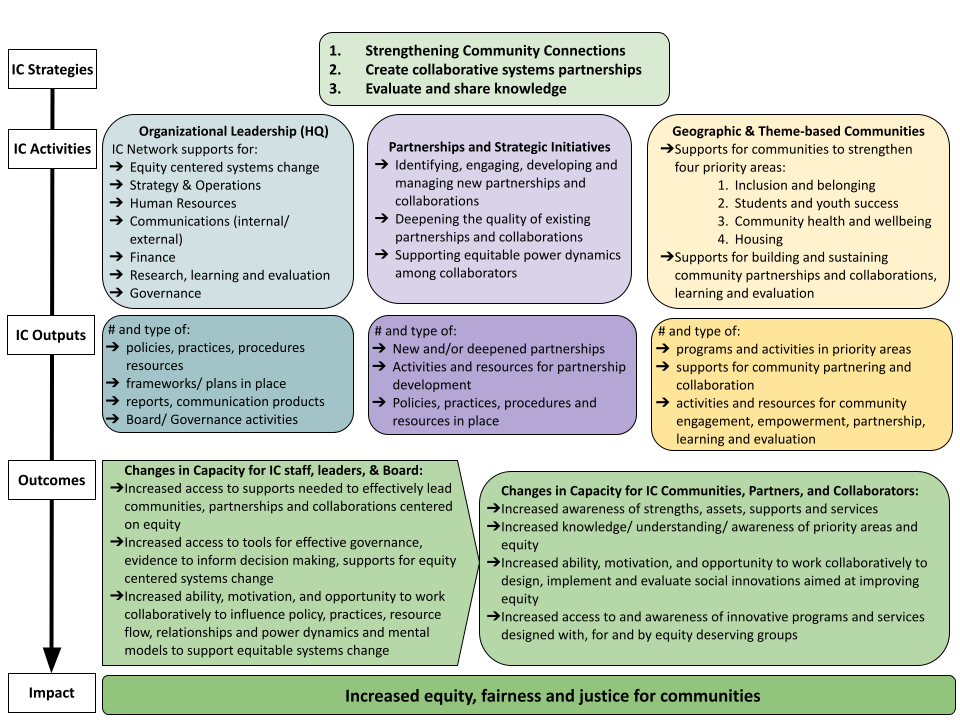Three Bridges: Bridges that Connect

by Nancy Carter, Evaluator
In the first post in our series, we talked generally about Inspiring Communities’ culture of evaluation and how it can be explained by looking at three types of bridges.
When you search the term bridge, you generally find some variant of ‘a structure to overcome obstacles.’ Evaluators have a role in building bridges that support program success by providing real-time feedback to program staff on their journey to support efficient and effective achievement of results. In this post, we will focus in on some of the ways Inspiring Communities has used evaluation as a connecting bridge.
Building connections was part of the initial mandate of IC to develop community building initiatives using a Collective Impact framework; its founders recognized the need to work across government departments and to build trust and relationships with communities to tackle complex social issues.
Andrea Redmond conducted an appreciative inquiry case study of Inspiring Communities that investigated how IC established and sustained evaluation practice as a non-profit. Her study found IC’s approach aligned with John Mayne’s (2010) basis for a strong culture of evaluation, which includes:
- positioning evaluation as part of leadership,
- establishing infrastructure to support comprehensive evaluation across the organization, and
- using evaluation findings to support ongoing operations.
Redmond noted that from its outset, evaluation and the management thereof has been a function of Inspiring Communities’ core team. This structure has grown and shrunk over time as the organization has shifted approaches, but evaluation, learning and research have always been central to both the structure and mission of the organization.
Redmond’s study also reported that Inspiring Communities sustains and strengthens a culture of evaluation and learning by embedding these concepts in its organizational values and taking a reflective learning approach to using evaluation findings. For example, Lifelong Learning is a guiding principle for IC: “We are curious and open to innovation. We trust the process. We learn from each other.” For Inspiring Communities, reflection is a practice that is regularly encouraged. By reflecting together on evaluation findings, Inspiring Communities provides opportunities to improve connectivity, shared knowledge and understanding both within the organization and among partners. In this way, evaluation and learning is used as a bridge to strengthen collaborative efforts, build new relationships, and deepen existing ones.
Going deeper into our bridges metaphor, here is a look at some further examples of how IC has used evaluation as a “connecting bridge.”

Connections: Bridges in Action
Using Evaluation as a Bridge in the Community: Collective Impact and Developmental Evaluation
The early mandate of Inspiring Communities was to develop collaborative community building initiatives in three communities using the Collective Impact framework. Collective Impact initiatives are characterized by five core elements, of which one is a shared measurement plan. This meant the need for a comprehensive and shared approach to measurement and learning that would meet the needs of multiple and diverse groups was evident at the outset and was woven into the fabric of IC. The organization’s founders understood the need to engage in ongoing monitoring and evaluation practice to capture successes, share learnings and adapt to evolving demands of the communities it works with.
During this period, evaluation often focused on how well each project was doing in achieving community goals. Information gathered through developmental evaluation pointed to very early signs of change, and this continuous monitoring encouraged trying new approaches and trial experiments in community. For instance, in Northside Rising, the Rising Tide festival was an opportunity to experiment with a culture-based approach to deliver difficult information (about substance use in community), which proved to work well. Invictus, an experiment in community-based research, was presented in a more traditional presentation format and got a mixed reception. Regular evaluation and reflection by the Northside team connected the events and supported this analysis. This evidence subsequently informed the current approach of hosting a film series examining community trauma, mental health and stigma.
Using Evaluation as a Bridge Within Inspiring Communities
Evaluation in early years was focused primarily at the program level for IC’s three place-based communities. In 2022, Inspiring Communities engaged a student researcher to go through the years of Developmental Evaluation reports from collective impact experiences across the organization and document overall how the five pillars of collective impact had been implemented. By structuring this report around the five common factors of collective impact, they were able to compare experiences and draw out larger lessons from across the entire organization. Among the insights gained:
- Establishing the pre-conditions for real collective action is a long term, iterative and cyclical process.
- There is a challenge to engaging and representing a wide variety of voices in communities.
Sharing and reflecting on the findings of this report contributed to decision-making among the leadership team. For example, the first of these supports and underlines IC’s transition to an intermediary role, with its function of affecting policy: there is a need to influence governments and the funding community to move away from ineffective short-term projects. The second of these insights provided further evidence for IC’s strategic direction of centering equity, that is, proactively and consciously centering equity-deserving people in the work to ensure their needs are represented.
Recently IC engaged an external evaluator to gather data on its operations, strategies and community-based work. The study was guided by an organization-wide logic model that connected activities across the organization to shared outcomes. The goal of the report was to assess the extent to which IC’s work over the past year aligned with its intentions as established by the logic model.

IC’s Logic Model as developed in 2022-2023.
As part of this process the evaluator surveyed staff on their knowledge of IC principles and how they are used to guide IC’s work. Of the four guiding principles, Lifelong Learning emerged as a principle that is most well understood by individual team members and for which there is a high level of shared understanding. It was on average the principle most consistently implemented by staff and the principle most frequently noted as being implemented organization-wide. As summarized in the final report:
“The results demonstrated strengths in Lifelong Learning, which aligns with the number of ways IC incorporates it into their workplace culture and provides opportunities to implement it.”
In summary, evaluation has been a cornerstone of IC since its inception and used as a tool to establish, sustain and strengthen connections both internally and externally. Evaluation activities, processes and findings have been used to overcome obstacles, to improve outcomes and to support IC through its own growth and transformation. Over the years the organization has relied on evaluation and learning to navigate its own growth, while responding to the everchanging and transforming systems in which it works. In the next post, I will reflect further on how a culture of evaluation supports IC to build sustainable bridges that can weather storms and be adapted as needed to remain useful.
Previous Post: Three Bridges: IC’s Culture of Evaluation
Next Post: Sustaining and Using Bridges
Reference:
Redmond, A. (2020). An appreciative inquiry case study of evaluation practice in a non-profit organization: Discovering the factors of a sustained practice. St. Francis Xavier University. Unpublished Masters’ research paper.
Images:
Photo by Pixabay: https://www.pexels.com/photo/bridge-over-a-lake-during-day-time-210364/
Share this:
Comments are closed